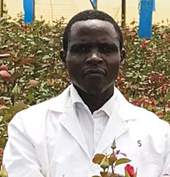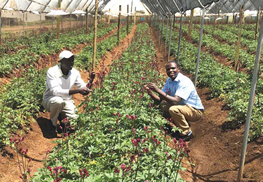Bridges the Gap Between Supplier and Grower
 What is your personal back ground?
What is your personal back ground?
I am an agronomist and marketer with diverse experience in the agriculture sector. Originating from the cotton and sugar belts of Nyanza and raised up in the green highlands of Kericho, I graduated with BSc. Agriculture from the University of Nairobi in 1998 and a holder of MBA (strategy and marketing majors) from the same university as well. Professionally I am member of the British Professional register-BASIS and a holder of internal Diploma in Ground Application technology (KAHA field and Research station, Egypt).
After undergraduate training I joined Brooke Bond as a tea propagator and later as a Team leader in their field operations in Jamji and Kimari respectively. In the year 2001 I joined Finlay flowers where I worked till joining Syngenta in 2007.
On the family front I am happily married and a proud father of two daughters.
Why did you choose to be an agronomist?
It’s a long story. I used to admire how Brooke Bond Tea Company was professionally managing the tea bushes and cinchona trees plantation. One day in 1994 I found myself in Upper Kabete campus studying Bachelor of Science in Agriculture and from then I developed interest in plant physiology. In fact, my favourite read to date has been Plant Physiology by Salisburry and Ross.
How long have you been working with flower growers?
I have been in the agriculture sector for the last 19 years basically working with multinationals: Brooke Bond (now Unilever Tea Kenya Ltd), James Finlays Kenya and now Syngenta Kenya as a Key Accounts Manager for Lawn and Garden business unit. Out of the 19 years only three years were outside the floriculture sector.
Briefly discuss the challenges you go through daily? What would you point out as your strongest attribute that has made you succeed?
Challenges are unique with every job. Clients’ needs vary from region to region and from farm to farm. My job is to add value and see my clients being successful in their businesses and therefore it’s upon me to be up to date with current information and technology that offers the best solutions to the grower not only in the field of pests management but to the business process as a whole. Knowledge and clients engagement are paramount for success in this field. The urge to get things done, the desire to learn and the push to leave a positive memorable legacy not only in the professional life but as well as in my social life keep me going. Having done everything else I call upon the Supreme God for guidance and help. Philippians 4:13, “I can do all things through Christ who gives me Strength” is a special encouragement to me.
In your experience, discuss some of the challenges flower growers are facing?
The business environment is dynamic. From the first cut flower export in the early ‘80s to the current dispensation, flower firms are faced with business cycles which are very dynamic. Emerging and new markets with stringent regulations, Forex fluctuations leading to forex loses and higher input cost, flower auction price unpredictability, multiple taxations at county and central government levels, new emerging pests and adverse weather conditions are a challenges facing growers in the face of increased competition mainly from South America countries. To sum it up the business environment and rising production costs is a concern for many growers. Going forward flower firms need to embrace efficiency, lean operations, waste and waste reduction to operate profitably. An all-inclusive approach, like the KAIZEN can create a positive attitude amongst the employees and in the long-term lead to business sustainability.
How do you rise up to the greatest challenge that your job presents?
Motivation to serve and offer growers sustainable solutions keeps me going. I would like to leave a positive impact to the industry and to the people I interact with. I do read and consult a lot to equip myself with solutions for the client. Like in any other job there is pressure and one need to be resilient and patient to succeed.
 Point out the solutions Syngenta EA Ltd has for the flower sector?
Point out the solutions Syngenta EA Ltd has for the flower sector?
Syngenta is a R&D company and a brand with the growers. Sustainability is core with all Syngenta solutions and with well trained and competent staff, Syngenta is out to assist growers bring crop potential to life. Syngenta offers solutions for all pests and diseases affecting the flower industry in particular and farming in general. Nematicides, Miticides, Insecticides and Fungicides that have passed the test of time are all in our portfolio. Ridomil, Folio gold and Revus are household names when it comes to downy mildew management. New products introductions of Tervigo, Hicure, Arima and more recently Solvit offer growers value for money and greater returns on investment. It also has to be noted that Syngenta has taken a leading role in shaping the biostimulant segment by educating growers on different types of biostimulants and their role in crop stress management and yield improvement.
Every professional grower should watch out for the upcoming new products from Syngenta.
A part from pests’ solutions, Syngenta through its competent staff offers growers tailor made technical trainings on pest and disease management as well as on safe, efficient and effective use of pesticide to ensure worker safety and production sustainability.
What is the role of the agrochemical sector to the development of the flower Sector?
Agrochemical firms and the ornamental growers complement each other in business. The growth of either has a positive impact on the other and vice versa. For example, as R&D agrochemical firms invest in new sustainable solutions for the benefit of the cut-flower firms to improve their productivity and income. The agrochemical sector play important role in providing solutions for flower growing, trainings to the farm workers to better understand usage of production inputs and how to use them safely and sustainably. The sector is also involved in CSRs activities geared towards conservation of the environment and water catchment areas. Rhino Charge is one such completion geared towards protecting the Aberdare water tower.
How do you see Syngenta EA Ltd contributing to the future of the flower sector?
Continuous investment in Research and Development of new, noble and sustainable solutions that encompass a wholesome approach to cut-flowers production. Staff empowerment through trainings is also an area Syngenta has heavily invested in.
Growing up, who was your inspiration?
My parents. They worked hard to ensure we had the best in life.
What decisions have you made in your career that looking back you feel were mistakes and you learned from them?
I know people make decisions which may at times not lead to the best of outcomes and its part of learning and growth. My philosophy is to do my best in the execution of my duties anchoring on the available resources and knowledge of the time. Having said this I don’t remember any one outstanding decision that I may regret.
Describe your ordinary day? Do you have enough personal time?
We all have 24 hours a day. The employer legally takes 8 hours and the remaining 16 hours is “personal time”. Safe for Sunday and Saturdays, my day usually begins at 4am and I surrender to bed at around midnight most of the times. I start with having quiet time with God in the morning and also the last thing in the night. In between there is strategizing, planning, reviewing and executing the daily objectives. My job involves lot of travelling meeting clients and therefore I also set some time just to rest.
What legacy do you want to leave behind in the flower sector?
I would like to be remembered a long side the veterans who did wonderful job in developing the sector in early years. I want to be a role model to the upcoming agronomists. A brand that growers can identify with and consult at any time, in any situation.
Give your final comments
The flower industry plays a noble role in creating productive employment and private sector development which at the end of the day generates income and improve lives. There is need therefore for the sector and industry players to match available resources with the dynamism in the environment to overcome the constraints of production and marketing. With world population projected to reach 9.8 billion people and the changing lifestyle amongst the younger generations, I strongly believe there is a brighter future in this sector. What is needed is to be diligent and focused on our roles.
Thank you.


